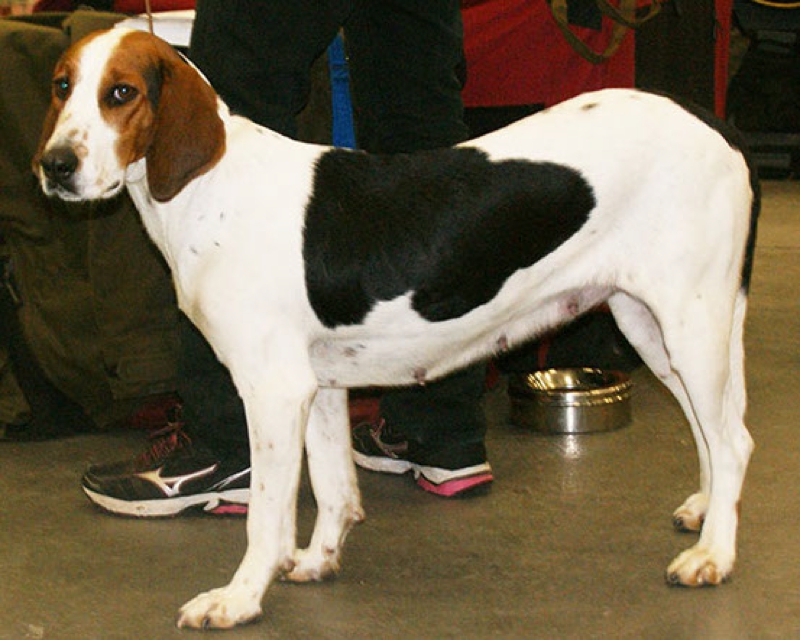Halden Hound
The medium-sized Halden Hound originated in Norway about one hundred years ago through the breeding of the Beagle and a variety of other European hound dogs. This scent hound should be solidly built, with pendulous ears, an athletic body and long limbs. Bred to hunt Norwegian hares, it is essential that this dog exhibits impressive speed and stamina when out working.
A good example of a working dog that is equally suited to life within the home, the Halden Hound gets on remarkably well with humans and enjoys spending time in their company. At times independent, this breed is not recommended for an inexperienced owner, as it can be tricky to train.
About & History
The Halden Hound, or Haldenstøver, is a breed of hunting dog that was developed in Norway around a century ago. The name ‘Halden’ is a reference to their place of origin: a town in southeastern Norway that borders Sweden.
This breed of dog has traditionally been used to hunt small game, such as hares, often hunting alone rather than in packs. The Halden Hound is a scent hound that relies on its nose to locate its prey. They have evolved over time to be quick on their feet; an essential trait when your aim is to catch an animal as fast as a hare! They are also capable of thriving in the cold climates and varied terrains of Norway.
It is thought that the Halden Hound came about by breeding a mix of Swedish, English and other European hounds. It is often stated that the English Beagle was a big genetic contributor to the breed.
The Halden Hound is an incredibly rare breed and has been under threat practically since its development. Both World Wars and disease outbreaks have reduced its population size over time. In recent years, there have only been a handful of puppies registering within their native Norway annually, with none being registered internationally, putting the breed at serious risk of extinction in the near future. It was not until 2006 that the UKC recognised the Halden Hound within their scent hound group.
Appearance
Those familiar with the American Foxhound, will see a close resemblance in the Halden Hound. This dog has a rectangular shaped body that should be robust but not overly heavy. Their medium-sized head exhibits a domed skull. Their nasal bridge and muzzle are long and straight. Their lips are not as pendulous as many other hounds and should not appear droopy. Their nose must be black with wide nostrils. As with many other hound dogs, their eyes are one of their true endearing features and should be a dark brown with a peaceful expression.
Their floppy ears are not overly long and often curl outwards, framing the face handsomely. Their straight limbs are well-muscled and strong, ending in oval feet that are tightly knit and well-adapted for snowy conditions. The Halden Hound has a deep chest and a straight top line with a croup that slopes gently. Their tail must not be too short and should reach their hocks. A working dog by trade, none of its features should be exaggerated.
The short coat of the Halden Hound has no undercoat to keep them warm but is sufficiently dense to ensure they are comfortable in the winter. They have tri-colour fur: white with tan on their face and legs and black patches that should not predominate.
Male Halden Hounds measure from 52cm to 59cm, while the more petite female will typically reach heights of between 50cm and 57cm. Breed members generally weigh anything from 18kg to 25kg.
Character & Temperament
Bred primarily for their hunting ability, the Halden Hound is best described as an energetic worker with notable stamina and a strong work ethic. Often used as a solo hunter, this breed can be quite independent. Despite its start in life, many Norwegian families are now choosing to keep the Halden Hound as a non-working companion animal, and it would seem that it has taken to its new role well.
Within the family home, the Halden Hound forms strong bonds with all of its family members and is particularly loving and gentle with those it trusts most. There is a trend for this dog to become over-reliant on its family members and separation anxiety can become an issue.
When it comes to protection, the Halden Hound makes quite a reasonable watch dog, keen to alert its owner of any new arrival. A Halden Hound would make a poor choice for a guard dog however, due both to their lack of aggression and their cautious nature.
Trainability
Benefitting from an experienced handler, the Halden Hound can be known to take advantage of any hesitation or uncertainty a novice trainer shows. They require the use of a firm training method as they often possess a stubborn streak when it comes to learning new tricks and behaviours.
An owner should aim to adopt the role of the ‘alpha’ within the relationship to avoid the Halden Hound becoming unruly and questioning basic instructions. Once respect has been earned, this is a dog that will obey its owner’s requests and responds well to verbal praise and encouragement.
Health
With an average lifespan of between 10 and 12 years, the Halden Hound generally enjoys good health. When thinking of taking on a Halden Hound, you should be aware of the following potential health conditions:
Hip Dysplasia
One of the most common breed dispositions, hip dysplasia is an orthopaedic condition that is prevalent in the canine world. As there is a simple screening test for this genetic disease, it is advisable that breeding parents have their hips checked before being mated. An animal’s hips are X-rayed and they are given a hip score. The score that each hip receives is added together, and the aim is to have a low hip score, with 0 being the optimum result.
Ear Infections
The bane of many hound dog owners’ lives, ear infections can be particularly frustrating to both treat and cure. In the erect ears of dogs, such as Chihuahuas and Corgis, there is plenty of drainage and air flow, meaning that ear infections are less common. However, in breeds such as the Halden Hound that have drop-down ears, moisture and debris often get trapped inside the ear canals, leading to infections.
General Injuries
If used for hunting, the Halden Hound is at an increased risk of sustaining injuries when outdoors, particularly if working over rough ground. Stick injuries, foreign bodies, strained muscles and lacerations are all much more likely to occur in a working dog. The natural adrenaline a dog produces when on the hunt means that any pain they may experience is often masked until they arrive home and take some time to calm down.
Exercise and Activity Levels
The exercise requirements of this hound should not be under-estimated. Best placed in a home with an active lifestyle, the Halden Hound enjoys the opportunity to join their family on long hikes and runs. In fact, any offer of an outdoor activity will be gladly accepted by the Halden Hound. Not suited to apartment life, this breed does best in a rural setting.
Once sufficiently exercised, the Halden Hound is more than content to peacefully relax inside the home. However, this is not a dog that can be left home alone all day, as to do so would likely result in you returning to a house that is far messier than how you left it. If not using the Halden Hound for hunting, they need another task to keep them occupied. A smart dog, they enjoy the opportunity to participate in scenting trails.
Grooming
Not known for heavy shedding, the Halden Hound only requires brushing once or twice a week to remove dead fur. Baths are not necessary more than a few times a year, and dry shampoo can be used in between baths if an owner finds the odour of the coat offensive.
It is essential that the pendulous ears of the Halden Hound are checked regularly. Many breed members will be prone to developing a waxy build-up and will need a cleaning once or twice a month.
Famous Halden Hounds
An exceedingly rare breed of dog, there are no celebrity Halden Hounds in existence today and, whilst there's only a small selection available to view on Instagram, these photos will give great insight into a day in the life of your average Halden Hound.
Cross-Breeds
There are no well-established Halden Hound cross-breeds.



